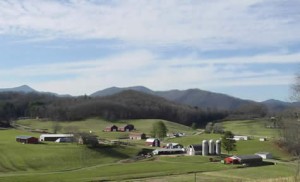The best way to lure people away from the mid-week routine is free food.
The best bait? A gratis organic vegetable production workshop (under the brand new NC State-led Mountain Organic Research and Extension Unit) with lunch being a rainbow selection of heirloom tomato sandwiches. The hosts of the event were NC State’s Department of Horticultural Science, (led by Dr. Jeanine Davis and project coordinator, Emily Bernstein) in the idyllic setting of the Mountain Research Station in Waynesville, N.C. on Tuesday, August 31st.

The insatiable public appetite for both organic gardening and juicy heirloom goodness guaranteed attendance (115 counted) from even the most nomadic members of the woodwork. A smattering of farmers, hobbyists, crop scientists, garden store and co-op reps, and students gathered to hear to latest techniques on organic crop production.
Oh, and to have a tomato sandwich or three.
The workshop broke down into four sections:
- The performance of heirloom and heirloom-type hybrid tomatoes under organic production systems.
- Organic weed management options for peppers
- Fall broccoli production opportunities and challenges
- Tomato grafting
The first part of the workshop (performance of heirlooms and hybrids) was conducted by Dr. Dilip Panthee. His lab stood rows deep in the vast greenery of the station, with his subjects being tomatoes of all sizes and prisms. Panthee’s ongoing mission consists of finding the best heirloom or hybrid grown under organic conditions. Surprisingly, the eleven different heirlooms (with regal names like the Black Prince) performed slightly less than the six different hybrids (all devoid of names, only serial numbers) in three categories–yield, taste, and disease resistance. Panthee stated that this study will not be released until next year, but he is currently looking for organic growers and greenhouse owners to possibly grow the six hybrids.
The second section–Comparing Weed Barrier Options for Organic Peppers–was led by Dr. Davis and Emily Bernstein. Once again, the crowd witnessed a living lab; this time with peppers as the guinea pig.
The peppers grew in five different row stations:
- Black plastic mulch
- Landscape fabric mulch
- Straw mulch
- A living mulch–clover
- Bare ground with no cover
The landscape and fabric mulch did the best overall for both yield and the least time for weeding. However, Davis quickly added that the season was not over, and the yields from both straw and living mulch were catching up.
To be continued…
Next Up:
- See what happens when mild mannered workshop participants are actually asked to “work”.
- Is grafting the answer to glutinous tomato yields of the future?
- Will workshop attendees be able to brave their way through fresh heirloom sandwiches and taste tests?


Leave a Reply